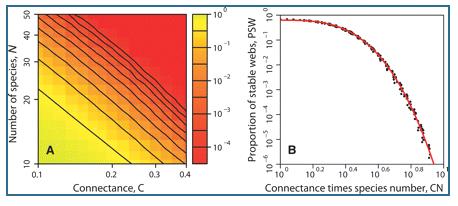博文
论文选读: 生态网络的复杂性影响稳定性吗?
|||

Fig. 1 The more connection and species, the more unstable
Recently my former group published one paper about the stability of complex food network in the journal 'Science'. This is not my direction. But I am near enough to understand their ideas of research.
The basic question came from Robert May in the 70s. He found that there is a dilemma between the theory and the observation. People generally believe that the diversity in an ecological system makes it stable. But May showed it mathematically that with increasing connection links and interactive nodes, an ecological system will become more and more unstable. People with the experience of solving large nonlinear differential equations know that the system becomes more and more difficult to have steady states if the number of equations increase. So
Which is correct: our intuition or our model?
In this papery, they used a small trick before the simulation. If there is a steady state in a dynamic system, you can always re-scale the time for different variables to normalize one steady state to an unit vector = (1, 1, ..., 1). Then you can do usual stability analysis around this point. Based on Monte Carlo sampling of different parameters, you will know how they effect the stability of the system around this steady state locally.
Using this half-analytical-half-numeric method, they generated 100 million food webs randomly and made a statistic how different factors effect the stability. They found that more connections and more species really de-stabilize the ecological system. That is, in a forest, if trees, birds, insects etc. form more connections and there are more species, the ecological system in this forest will be more inclined to collapse! (Really unintuitive?) The other conclusion is that the food web will be more stable if top predators like lions, tigers die fast, or they can eat more deer when deer population increases.
This kind of idea is actually not new. In 1960s, when Kauffman tried to study the gene regulatory network of the living organism, he did the same thing by creating millions of random networks since the real genetic networks would come decades later (He simply can not wait). Based on his statistics on all these random gene networks, Kauffman concluded that if we need an evolution in Life, we have to have our gene network at the edge of Chaos. That is, it is not either in deterministic system with the fixed number of steady states, nor in totally chaos without any steady states at all. It is just at this delicate zone in between.
Could this complexity analysis with large number of simulations will reveal more 'emergent properties' in Life? Let's just wait and see.
Ref: Thilo Gross, Lars Rudolf, Simon A. Levin, Ulf Dieckmann, Generalized Models Reveal Stabilizing Factors in Food Webs, Science 7 August 2009, Vol. 325. no. 5941, pp. 747 - 750,DOI: 10.1126/science.1173536
<END>
https://blog.sciencenet.cn/blog-3468-255843.html
上一篇:美国大学中的读经学院
下一篇:Two biophysics positions due in October, 2009